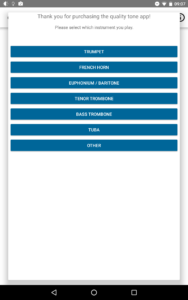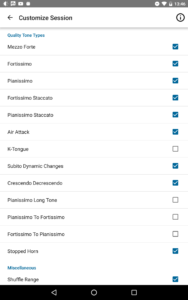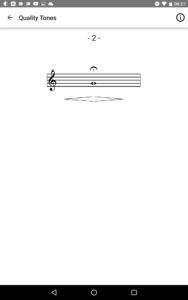Accuracy is probably the number one concern for most beginning to intermediate horn players. Until your ear, embouchure, and air become well developed, hitting the correct note – especially the first note – can seem like a crap shoot. That is precisely what the developer of the Quality Tones app wants to improve.
What Are Quality Tones?
Although I don’t know exactly who started it, I’ve heard several prominent horn players refer to long tones as “quality tones”. I very much like this term and the though process that it (hopefully) inspires. It certainly helps me to approach what can be a boring (but very necessary) part of any practice routine by thinking about what my goal should be (quality tones) rather than how long it takes (long tones).
What Does the Quality Tones App Do?
This app is, at its most basic, simply a randomizer for notes, dynamics, and articulations. This doesn’t change its value, however, since the (selectable) randomness will force you to confront notes and/or dynamics and/or articulations that you either may not be comfortable with or would not have thought of on your own. This is a great tool, since the first step to improving any aspect of your playing is knowing that you have a weakness.
The app has many options – such as selecting a highest and lowest note, selecting the dynamic level, selecting the note length, how to start the note (normally, air, or “Ka” syllable), and even dynamic changes (gradual or suddenly) within the specific note. Additionally it is possible to add stopped horn notes into the mix, practice only on a single note through all the dynamic and articulation options, or ascend by half-step instead of randomly choosing notes. Suffice to say you won’t run out of options anytime soon with this app!
Here are some pictures of the app:
Does It Work?
Yes – to a point. This app is basically a changing and customizable version of Philip Farkas’ “Random Attacks” from his Korg CA-1 chromatic tuner, along with some additional long tone and dynamic studies added in. It’s really a great way to hit quite a few birds with one stone, but there are some things to keep in mind:
- Unless you’ve got an excellent ear, you’ll need a tuner – especially for the notes that change volume over a few beats. The tuner will help you make sure you’ve played the correct note (no sense in practicing these if you’re not 100% sure you’re on the right note!) and it will help you maintain the same pitch throughout the (sometimes drastic, sometimes gradual) dynamic changes.
- A metronome would probably be a good idea too. One of the challenges of first notes is playing them in time, and having a metronome set to a moderately slow tempo (72 or so) would help to accurately place the notes right in time.
- Many students use tuners and metronomes on their phones – this may present a challenge when using this app. A metronome shouldn’t be a problem, since it will keep on clicking when you are using another app (at least, it should!) but you’ll need either a separate phone/tablet to use a tuner app, or you’ll need a separate tuner. If you do want an inexpensive stand-alone tuner, the Korg CA-1 chromatic tuner or the clip-on Snark SN-8 are both good options for under $12.
All in all, however, this app is a great way to practice one of the most important aspects of horn playing (but also one of the most boring). All the range and dynamic variation options make this app appropriate for a very wide range of students – from middle school all the way up to college.
Download Quality Tones App
The Quality Tones app is available for both iOS and Android devices. It costs $3.99, but it is well worth for the variety of exercises it is capable of.
A longer list of apps for musicians is available here, and all my app reviews can be found here.









Leave a Reply